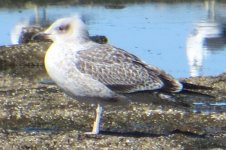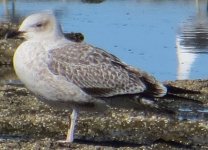-
Welcome to BirdForum, the internet's largest birding community with thousands of members from all over the world. The forums are dedicated to wild birds, birding, binoculars and equipment and all that goes with it.
Please register for an account to take part in the discussions in the forum, post your pictures in the gallery and more.
You are using an out of date browser. It may not display this or other websites correctly.
You should upgrade or use an alternative browser.
You should upgrade or use an alternative browser.
Gull (1 Viewer)
- Thread starter Hippolais
- Start date
More options
Who Replied?This bird is a juvenile, large gull. No (or possibly a few small mantle feathers) have been moulted. Considering the date I assume that this should really exclude any gull breeding in southern hemisphere and it strongly points to a bird fledged late and thus probably far north. The bird has short legs and a small bill and long wings. Gc is well barred only towards the wing base, pale fringes of tertials do not reach coverts. Maybe Herring Gull should be considered a default species, but structure and e.g. tertial- and coverts pattern are not typical for that species. It should be very exceptional to find e.g. an cachinnans or michahellis with this moulting status in late Sept. LBBG fuscus moults late and structure and plumage matches this species well. That’s my guess, but in real life practice I find that location is of great importance for the id process which I believe always involves using your general judgement to estimate probabilities.
lou salomon
the birdonist
1cy LBBG, probably intermedius. at this time of year the local, very similar 1cy YLG are more worn and have replaced several scapulars and poss. also some coverts.
tittletattler
Well-known member
1cy LBBG, probably intermedius. at this time of year the local, very similar 1cy YLG are more worn and have replaced several scapulars and poss. also some coverts.
Agreed. Also looks quite weak billed which doesn't suit Yellow-legged Gull.
Cheers, Andy.
Well, I would obviously not id this bird as a LBBG in Argentina based on these pictures where I guess its occurrence is still very unlikely even though numbers in North America are constantly increasing. On checking Gulls … (Olsen & Larsson) I find that juv Kelp should be expected from August (earlier than what I assumed in my earlier post), but I’m still a bit confused since my impression is that the mantle feathers on the depicted gull looks rather worn. A main id key for differentiating Kelp from LBBG should be the deep bill with pronounced gony angle. Seems difficult to apply in this case. Noting that this is a young bird with perhaps not fully grown bill. gender dimorphism and the vast variation among gulls in general, I would say it would be fairly safe to id it as a Kelp. An interesting bird though. A more comprehensive literature study may reveal further plumage details to support this
lou salomon
the birdonist
there is no other large gull in argentinia like this, so it got to be a fresh juvenile kelp gull.
tittletattler
Well-known member
Well, I would obviously not id this bird as a LBBG in Argentina based on these pictures where I guess its occurrence is still very unlikely even though numbers in North America are constantly increasing. On checking Gulls … (Olsen & Larsson) I find that juv Kelp should be expected from August (earlier than what I assumed in my earlier post), but I’m still a bit confused since my impression is that the mantle feathers on the depicted gull looks rather worn. A main id key for differentiating Kelp from LBBG should be the deep bill with pronounced gony angle. Seems difficult to apply in this case. Noting that this is a young bird with perhaps not fully grown bill. gender dimorphism and the vast variation among gulls in general, I would say it would be fairly safe to id it as a Kelp. An interesting bird though. A more comprehensive literature study may reveal further plumage details to support this
Does put a different slant on things, it being from Argentina...
Some links to juv Kelp Gull would be useful.
Southern Frogmouth
Well-known member
It is certainly a pale bird and the inner greater coverts are surprisingly patterned for a Kelp Gull. But then I haven't seen too many South American birds. Given that Kelp is confusable with GBBG due to heavy bill this bird is certainly interesting.
Valéry Schollaert
Respect animals, don't eat or wear their body or s
Hi Hippolais,
I didn't reply because I ruled out all regular European species, but have not enough knowledge of gulls in the World to find out what it was.
Interesting game indeed...
I didn't reply because I ruled out all regular European species, but have not enough knowledge of gulls in the World to find out what it was.
Interesting game indeed...
Valéry Schollaert
Respect animals, don't eat or wear their body or s
I would have said argentatus Herring Gull and can't see anything against that. GC-pattern, tertial pattern and moult is ok for argentatus.
I excluded it because of too much contrasted tertials IMO. Weak bill is strange indeed, especially compare to such a massive body.
Valéry Schollaert
Respect animals, don't eat or wear their body or s
Hippolais,
I think it is not really a problem. Look at a juvenile Kelp Gull
http://www.surfbirds.com/community-blogs/wp-content/uploads/bghst/a/Alan/15884.jpg
Obviously, OP bird is much later, as mantle has moulted. I don't know in Patagonia, but in southern Africa it is more common than in Europe to have bird breeding outside usual expected season... so why not simply a late Kelp Gull?
I think it is not really a problem. Look at a juvenile Kelp Gull
http://www.surfbirds.com/community-blogs/wp-content/uploads/bghst/a/Alan/15884.jpg
Obviously, OP bird is much later, as mantle has moulted. I don't know in Patagonia, but in southern Africa it is more common than in Europe to have bird breeding outside usual expected season... so why not simply a late Kelp Gull?
I think it is not really a problem. Look at a juvenile Kelp Gull
http://www.surfbirds.com/community-blogs/wp-content/uploads/bghst/a/Alan/15884.jpg
Do we know the photo date & location?
Obviously, OP bird is much later, as mantle has moulted. I don't know in Patagonia, but in southern Africa it is more common than in Europe to have bird breeding outside usual expected season... so why not simply a late Kelp Gull?
My view is that all (or almost all) mantle feathers are of the first generation i.e. juvenile. Furthermore my feeling is that they are kind of worn, but maybe I misjudge this. According to Gulls … (Olsen, Larsson) juv. plumage Kelp occurs between August-January. Perhaps a little surprisingly the Antarctic population is said to moult several weeks earlier than more northern. Therefore a juvenile bird should be possible in Patagonia in late September, but its plumage ought to be in fresh condition. Is there any indication that this bird was at a breeding site? If anything this ought to be an early fledged Kelp.
Valéry Schollaert
Respect animals, don't eat or wear their body or s
Do we know the photo date & location?
The funny thing is that the gull was in Comodoro Rivadavia (Patagonia - ARGENTINA), in a place where normally there are only Kelp Gulls: so is it still Lesser Black-backed Gull?? Would be really an good find!!
Photographed the 24th September
My view is that all (or almost all) mantle feathers are of the first generation i.e. juvenile. Furthermore my feeling is that they are kind of worn, but maybe I misjudge this. According to Gulls … (Olsen, Larsson) juv. plumage Kelp occurs between August-January. Perhaps a little surprisingly the Antarctic population is said to moult several weeks earlier than more northern. Therefore a juvenile bird should be possible in Patagonia in late September, but its plumage ought to be in fresh condition. Is there any indication that this bird was at a breeding site? If anything this ought to be an early fledged Kelp.
Also fine for me. Still a Kelp Gull!
tittletattler
Well-known member
Kelp gull is obviously the default option. But this bird doesn't seem to confirm to how a juvenile Kelp Gull should look.
Its bill is weak and not broad. It is also rather pale especially so the underparts (even taking into account that the photo is overexposed).
Here are some juvenile Kelp Gulls:
http://www.surfbirds.com/community-blogs/falklandbirder/2011/07/17/kelp-gull-juvenile-to-adult/
Some 2nd gen scapulars, I reckon, on this one:
http://www.ozanimals.com/image/albums/australia/Bird/NT-kelp-gull-juv.jpg
http://cdn2.arkive.org/media/A6/A6C...entation.Large/Kelp-gull-adult-and-chicks.jpg
http://www.flickr.com/photos/22517893@N00/6944088856/
Cheers,
Andy
Its bill is weak and not broad. It is also rather pale especially so the underparts (even taking into account that the photo is overexposed).
Here are some juvenile Kelp Gulls:
http://www.surfbirds.com/community-blogs/falklandbirder/2011/07/17/kelp-gull-juvenile-to-adult/
Some 2nd gen scapulars, I reckon, on this one:
http://www.ozanimals.com/image/albums/australia/Bird/NT-kelp-gull-juv.jpg
http://cdn2.arkive.org/media/A6/A6C...entation.Large/Kelp-gull-adult-and-chicks.jpg
http://www.flickr.com/photos/22517893@N00/6944088856/
Cheers,
Andy
Last edited:
No, was not in a breeding site: it was the only one gull with juvenile plumage among hundreds of first winter, second winter and adult Kelp Gulls!
Looking to pics in the web, all juveniles of Kelp Gulls seem much more darker than mine and with heavier bill (like this http://www.surfbirds.com/community-blogs/wp-content/uploads/bghst/a/Alan/31079.jpg)... the more similar is this http://www.surfbirds.com/community-blogs/wp-content/uploads/bghst/a/Alan/15884.jpg, but anyway has been photographed in May...
But the gull looks much more like these other juvenile LBBG, also with the eye mask:
http://cdn2.arkive.org/media/F2/F21...n.Large/Juvenile-lesser-black-backed-gull.jpg
http://3.bp.blogspot.com/_rn7VOhVGQ...JmTOF2lK-8/s1600/Lesser+Black-backed+Gull.jpg
http://www.freewebs.com/merseybirders/1stw Lesser Black-backed Gull Feb08 1.jpg
Looking to pics in the web, all juveniles of Kelp Gulls seem much more darker than mine and with heavier bill (like this http://www.surfbirds.com/community-blogs/wp-content/uploads/bghst/a/Alan/31079.jpg)... the more similar is this http://www.surfbirds.com/community-blogs/wp-content/uploads/bghst/a/Alan/15884.jpg, but anyway has been photographed in May...
But the gull looks much more like these other juvenile LBBG, also with the eye mask:
http://cdn2.arkive.org/media/F2/F21...n.Large/Juvenile-lesser-black-backed-gull.jpg
http://3.bp.blogspot.com/_rn7VOhVGQ...JmTOF2lK-8/s1600/Lesser+Black-backed+Gull.jpg
http://www.freewebs.com/merseybirders/1stw Lesser Black-backed Gull Feb08 1.jpg
Well, everyone seems to agree that this does not look like a typical Kelp. Is it at all possible that the mantle feathers are in fact 2nd generation and the bird around one year old and in its late “1st winter plumage”? Doesn’t look so to me, but anyway is this an option? Could the bird be retarded and around 1 year old with retained 1st gen. scapulars? Again doesn’t look so to me. These two options would however fit pale head and underparts well. Having said this, I still think this most probably is a juvenile Kelp. I guess you would need better photos and a more detailed description to seriously claim a LBBG. As a curiosum I could mention that an Arctic Skua ringed in the Baltic sea was recovered on the east coast of Brazil a few years back, but wintering habits of these two species are quite different of course.
Are there any accepted records of LBBG in South America (as yet)?
Are there any accepted records of LBBG in South America (as yet)?
Users who are viewing this thread
Total: 2 (members: 0, guests: 2)





